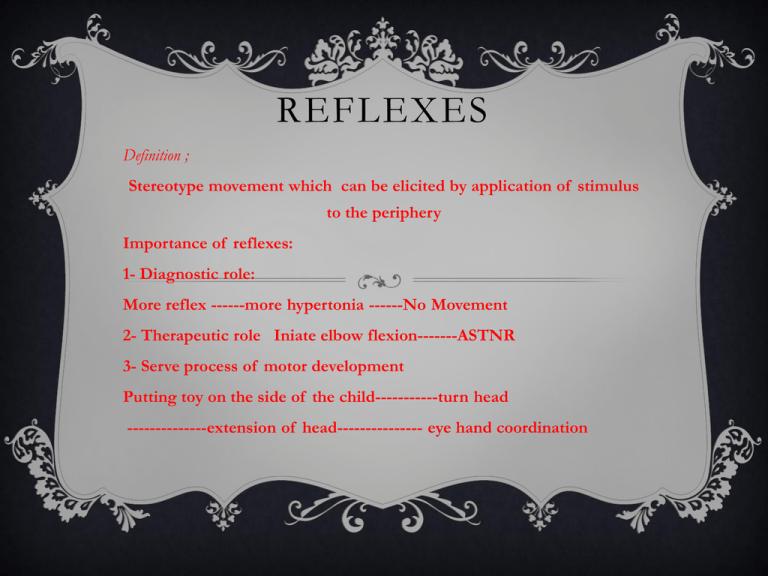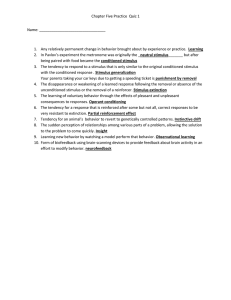Reflexes: Classification, Stimuli, and Responses
advertisement

REFLEXES Definition ; Stereotype movement which can be elicited by application of stimulus to the periphery Importance of reflexes: 1- Diagnostic role: More reflex ------more hypertonia ------No Movement 2- Therapeutic role Iniate elbow flexion-------ASTNR 3- Serve process of motor development Putting toy on the side of the child-----------turn head --------------extension of head--------------- eye hand coordination CLASSIFICATION OF REFLEXES According to level of CNS maturation According to type of stimulus ACCORDING TO LEVEL OF CNS MATURATION Spinal Level (Spinal reflexes) Brain Stem Level(Brain Stem reflexes) Midbrain Level(Midbrain reflexes) Cortical Level (Cortical reflexes) a- (Spinal reflexes) Primitive reflexes , phasic reflexes Movement reflexes A- beta reflexes: Flexor with drawl (nociceptive reflex) Starting position : Supine lying position, head in midline position, Stimulus : upper , lower limb extended Painful Scratching on sole of foot Response : Mass Flexion or uncontrolled flexion Age positive : from birth to 2 month b- extensor thrust : Starting position : Supine lying position, head in midline position, upper extended, lower ,one is flexed, other extended Stimulus ; painful stimulus on the sole foot of flexed Response: Uncontrolled extension of leg Age: From birth to 2 Month Crossed extension: Starting position : Supine lying position, head in midline position, upper , lower limb extended Stimulus ; Tapping on medial aspect of thigh Response: Extension , adduction, internal rotation of opposite scissor Age: birth to 2 months B ) B R A I N S T E M R E F L E X E S ( S TA T I C POSTURAL REFLEXES)(TONIC REFLEXES)(PRIMITIVE REFLEXES) Changing position of the body or head in the space will change distribution of the tone. 1- asymmetrical tonic neck reflex (ATNR): Starting position : Supine lying position, head in midline position, upper , lower limb extended Stimulus ; Turning the head to one side Response: Face head : extension of upper and lower limb occipital side: flexion in upper and lower limb Age: birth to 4- 6 months ASTNR interfere with ( ROLLING, FEEDING, both hand use) 2- symmetrical tonic neck reflex (STNR): Starting position : Quadriped or prone on my leg Stimulus ; Flexion of head Response: Flexion of upper limb and extension in lower limb Or vice versa Age: birth to 4- 6 months 3- Tonic labyrinthine supine (TLS): Starting position : head in midline position, Stimulus ; Supine lying position, Response: increase of extension tone in all over the body Age: birth to 4 months 3- Tonic labyrinthine prone (TLP): Starting position : head in midline position, Stimulus ; Prone lying position, Response: increase of flexor tone in all over the body Age: birth to 4 months 4- +ve Supporting reaction: Starting position :Standing with his back on my face Stimulus ; Hold the child from pelvic or axilla and bounce him on sole of foot. Response: Lower limb extension, adduction, internal rotation plantar flexion (scissors). Age: from 3 to 8 Months 5 -Ve Supporting reaction: Stimulus : Child in weight bearing with leaning forward Response: Semi flexion of lower limb with few steps forward Age: From 8 to continue throughout life MIDBRAIN REFLEXES RIGHTING REACTION A) Neck Righting; Starting position : Supine lying position, head in midline position, upper , lower limb extended Stimulus ; Rotation of the head to one side Response: Rotation of the body as a whole following head Age: birth to 6 months B) Body righting acting on body: Starting position : Supine lying position, head in midline position, upper , lower limb extended Stimulus ; Turning the head to one side Response: Segmental rotation of the body Age: from 6-18 months C) Labyrinthine righting on head: First: Starting position: prone in space with blind folded Stimulus: prone in space on my hand with blind folded Response: raising head to normal position age from 1-2 month then continue Second: Starting position: supine lying Stimulus: Supine in space on my hand with blind folded Response: raising head to normal position then continue age from 6 month s Third: Starting position: Holding child from pelvis blind folded Stimulus: tilting the body to right side Response: raising head to normal position age from 6-8 month then continue Fourth: Third: Starting position: catching the child from trunk Stimulus: tilting the body to Left side Response: raising head to normal position then continue age from 6-8 month D) Optical righting acting on head: THE SAME LIKE LABRYINTHINE (POSITIONS , RESPONSES) WITHOUT EYE BLIND FOLDED Amphibian Reaction :Starting position: Prone head in midline ,legs extended , arm extended overhead Stimulus: lift pelvis on one side Response: Automatic flexion of hip ,knee ankle on the same side Age from 6 month then continue Automatic Movement Reactions: Moro Reflex Starting position: Semi recline Stimulus: Drop head backward Response: Extension, abduction, external rotation of arms, extension, adduction fingers Age: Normal from birth to 4 months Landau Reflex : Starting position: prone in space with holding under thorax Stimulus: raise head active or passively Response: Spine and leg extend Age: Normal from 6 months to 2or 2.5 years Protective extensor Thrust( Parachute reaction) Starting position: Prone , arms extended over head Stimulus: Suspend the child from ankle or pelvis suddenly move child to floor Response: Immediate Extension , of arms,, fingers to protect head Age: Normal from 6 months continue through out life CORTICAL REFLEXES OR EQUILBRIUM REACTION SUPINE Starting position: supine on tail board Stimulus: Tilt board to one side Response: Righting head, thorax extension, abduction of arms, legs on raised side Age: Normal from 6 months continue through out life Prone: Starting position: Prone on tail board Stimulus: Tilt board to one side Response: Righting head, thorax extension, abduction of arms, legs on raised side Age: Normal from 8 months continue through out life Sitting: Starting position: Sitting on chair Stimulus: pull child to one side Response: Righting head, thorax extension, abduction of arms, legs on raised side Age: Normal from 12 months continue through out life Kneel Standing : Starting position: Kneel standing Stimulus: pull child to one side Response: Righting head, thorax extension, abduction of arms, legs on raised side Age: Normal from 15 months continue through out life Hopping 1, 2and 3:Starting position: Standing holding from upper arms Stimulus: Move to lift or right, forward, backward Response: Righting head, thorax extension, hopping steps to sideway, forward, backward to maintain equilibrium Age: Normal from 15 to 18 months continue through out life Dorsiflexion: Starting position : Standing holding from axilla Stimulus: Tilt child backward Response: Righting head, dorsiflexion of feet Age: Normal from 15 to 18 months continue through out life See- saw: Starting position: Standing holding hand , foot with flex hip knee Stimulus: pull arm gently forward and to lateral side Response: Righting head, thorax extension, slightly abduction of flexed knee Age: Normal from 15 months continue through out life Simian position Starting position: Squatting sitting Stimulus: Tilt child to one side Response: Righting head, thorax extension, abduction of arms, legs on raised side Age: Normal from 15 to 18 months continue through out life






